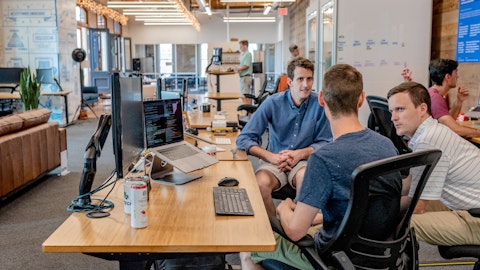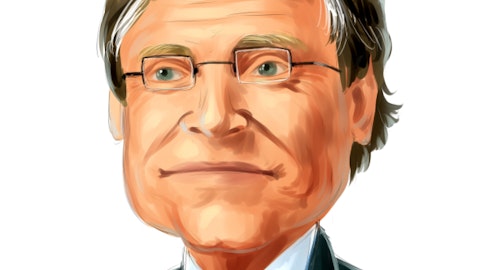As we sit here today, it’s a very dynamic market and ever-changing. A little hard to predict candid like is what we’re seeing today is for shippers who have high value packages, they’re actually — they’re worried about the ocean conditions, so they’re moving to the air. So air rates are tightening a bit. And on the ocean side, because shippers are starting to have to reroute away from the Red Sea or the Panama Canal, the routing is taking longer, so there’s some change to the dynamics of the pricing there too. We just have to stay super nimble here and Kate and her team are doing a great job at that. Kate, what would you like to add here?
Kate Gutmann: Yeah, I would say that the market remains volatile, even in Europe with the drop off in the inflationary softening. We were able to pull back on the cost to deliver a great margin, and that’s our commitment. And then to ensure that in the forwarding side of the house, as we’ve done, stay just razor sharp to ensure that we are right on track with any trend that we see. And I’m really proud of the team because we have got the initiative to gain those customers with high-value goods and that international air freight that’s coming as a result.
Jeff Kauffman: And just if I could follow up on that answer. So given the global events with Suez Canal, Panama Canal, looking at the lemonade out of lemons side of this, is this a bigger opportunity for you in Europe? Or is this a bigger opportunity for air out of Asia?
Kate Gutmann: It actually is first showing up Asia to Europe lane. And — but I will say this is going to be repositioning of vessels around the globe. It’s going to be a global event. So we see it as an opportunity throughout and our sales resources are global. Our portfolio is global. So UPS is very well positioned to take advantage of it.
Jeff Kauffman: Okay, thank you.
Brian Newman: Thanks, Jeff.
Operator: Our next question will come from the line of Brandon Oglenski of Barclays. Please go ahead.
Brandon Oglenski: Hey, good morning, and thanks for taking my question. Can you guys speak to your enterprise customers and the volume trends that you saw in the fourth quarter and expectations going into 2024? And maybe compare and contrast that with B2B as well as your small, medium business mix?
Brian Newman: So happy to, Brandon. We were actually pleased with the volume momentum. We were at a low watermark in August of last year, down 15%, and we saw sequential monthly improvement as we looked at our volume domestically from an ADV perspective, down to mid-single-digit declines in the month of December. So that trend continues to play out well. We’re going to see some tough comps, though, in the first quarter, so I wouldn’t expect positive volume growth in Q1. We start to see positive volume growth in Q2 and then certainly in the back half of the year as the comps change. SMB, Carol mentioned, very focused on penetration on the SMB side and specifically some of the medium SMB customers. We’ve stated we would like to see that mix trend up to 30% plus. We finished the year at 28%. So we’re well on our way in that direction.
Carol Tome: Maybe another comment because this is just an interesting observation on the market. If I look at our top five decliners in the quarter, that would include our largest customer and there’s an intentional decline there. But then if I look at the remaining decliners, it’s really interesting to see what’s happening. Of those, only one has diverted some volume. They’re a dual sourcer and they have diverted some volume. And I suspect they’ll stay dual-sourcing. The rest, either their business is just way off or they have worked really hard to create a better experience inside the store to encourage buy online pick up in store. So there is a bit of dynamic happening within our large enterprise customers. I think for all of us, we’re delighted to have anniversaried the demand that we saw through COVID. Now that that’s behind us, now that the volume for the small package market has reverted back to the mean, this is an opportunity now for everyone to grow.
Brandon Oglenski: Thank you both.
Brian Newman: Thanks, Brandon.
Operator: Our next question will come from the line of Helane Becker of TD Cowen. Please go ahead.
Helane Becker: Yeah, guys. Thanks very much, everybody, and thanks team for the time. So on Coyote, when you did the acquisition, what did you think the benefits would be that made it important to do the acquisition? And then what really would actually happened that is causing you to rethink how Coyote fits in the network? And my follow-up question is then related. You recently bought two 747-8 freighters, I saw. And I’m just wondering if you bought those off lease or where they came from since Boeing doesn’t make the 747 anymore? Thank you.
Carol Tome: I’m happy to address the Coyote question to the best of my ability. I was on the Board in 2015 when we bought the company but the strategic rationale was really about expanding the portfolio. And it was a very thoughtful strategic rationale to expand the portfolio. But I don’t think we fully understood at the time was just how cyclical this business is. And I’ll make it real for you. When we acquired Coyote in 2015, the revenue in the previous year for Coyote were $2.1 billion. During COVID, Coyote peaked up to over $4 billion in revenue. Well, it’s gone way down since then. In fact, if you look at our Supply Chain Solutions business, it was down $3 billion year-on-year, which is a third of the overall company decline.





